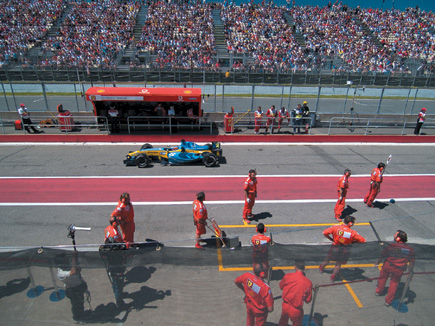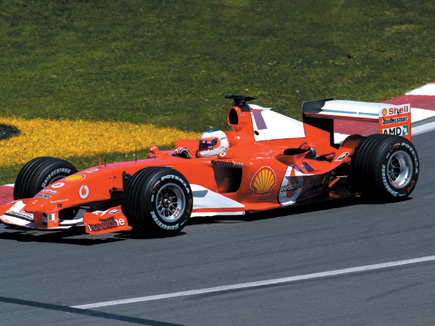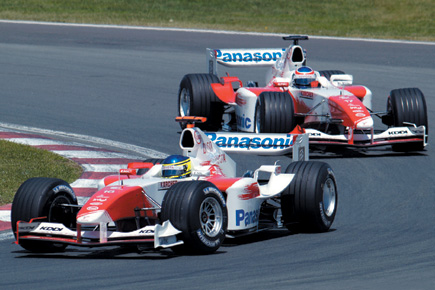Zuiko Digital 300mm f/2.8 ED And 11-22mm f/2.8-3.5 Lenses
The Long And The Short Of It For The Olympus D-SLR System
All Photos © 2004, Peter K. Burian, All Rights Reserved
The first interchangeable-lens autofocus SLR produced by Olympus, the E-1 was
also the first digital camera to employ a "Four Thirds" CCD sensor.
The smallest imager in any digital SLR camera, this one is roughly half the
size of the 35mm film frame standard. Consequently, the effective focal length
of any lens is doubled. That effect is actually a field of view crop but it's
significant, offering both pros and cons. It's great for telephotos, because
a relatively small/lightweight lens can be very powerful in terms of effective
"reach." Of course, there's a drawback with wide angle lenses.
On a camera with the small sensor, an ultra-wide 20mm lens produces an angle
of view of only 57Þ instead of the expansive 94Þ available in the
35mm format.
Olympus has taken advantage of the field of view crop with telephotos such as
the Zuiko Digital 300mm f/2.8 ED for a 600mm equivalent focal length. And the
company solved the wide angle problem by designing very short lenses, such as
the 11-22mm f/2.8-3.5 zoom, equivalent to a 22-44mm zoom. We expect to see even
shorter focal lengths in the future. During a trip to Montreal, Canada, I was
able to test the longest and shortest Olympus lenses during travel and Grand
Prix racing photography.

Zuiko Digital 300mm f/2.8 ED
Tiny and featherweight when compared to the massive 600mm f/4 lenses used by
many sports and wildlife photographers, the 300mm f/2.8 lens is very portable
and produces nearly the same effective "reach." I carried it around
the race track for three days (on a monopod) without complaining, and occasionally
used it for handheld photography. This is a very rugged lens designed to withstand
pro-level abuse; like all Zuiko Digital lenses, it's also splashproof.
The aluminum alloy barrel includes a wide manual focus ring (well damped), a
removable tripod mount, rear filter slot for neutral density and polarizing
filters (included), a focus distance limiter switch, and a focus-stop button.
I found the latter very useful for locking focus on a static race car after
a crash while the E-1 camera was set for continuous autofocus.
The optical system includes three ED (extra low dispersion) glass elements to
effectively correct chromatic aberration, for high sharpness plus freedom from
comatic flare and color fringing even at f/2.8. That's an extremely wide
aperture, not available with any 600mm lens in 35mm systems. It allows for faster
shutter speeds in low light, or for making images with extremely shallow depth
of field. Internal focusing maintains optimal weight balance at any focused
distance. Finally, the diaphragm incorporates a full nine blades. This renders
any out-of-focus highlights in the background as circular, instead of hexagonal
at smaller apertures, for a more pleasing effect.
|
|
 |
|
|
Evaluation: The combination of advanced autofocus (in the E-1), internal focusing, and electronic lens mount provides fast autofocus response with superior starting/stopping. The continuous tracking autofocus system was quite reliable with race cars approaching my position, slowing and turning; many of my images, made on sunny days, are razor sharp. Even at f/2.8, the Zuiko Digital telephoto produced remarkably high sharpness, contrast, and resolution, rating a 9 on my subjective scale of 1-10. Color fringing is visible only in a few backlit images, and only at 300 percent or greater monitor magnification. I would happily shoot all day at f/2.8, although edge sharpness does increase slightly at f/5.6 for an overall rating of 9.6. With the EC 1.4x tele-converter, image quality was still very good at the widest aperture (an effective f/4) meriting a rating of 8, but edge sharpness increased at f/8, leading to a rating of 9.
Zuiko Digital 11-22mm f/2.8-3.5
At the other end of the spectrum in size, price, and focal lengths, the wide
angle zoom also boasts a professional look and feel. Slightly larger than a
Tamron AF 20-40mm f/2.7-3.5 zoom (the closest equivalent in a 35mm system),
it's 3 oz lighter. The barrel includes large, dual-sided aspherical glass
elements to reduce distortion and to produce higher edge sharpness by forcing
light rays entering at the edges to focus accurately on the image sensor. To
minimize flare in backlighting, a new multilayered coating was applied to the
first two elements. Thanks to internal focusing, the front element does not
rotate, so the effect of a polarizer or graduated filter does not change. Finally,
this zoom includes a new close-distance aberration compensation mechanism to
deliver sharp, high-contrast images even when focused to 11".
 |
|
|
- Log in or register to post comments


































